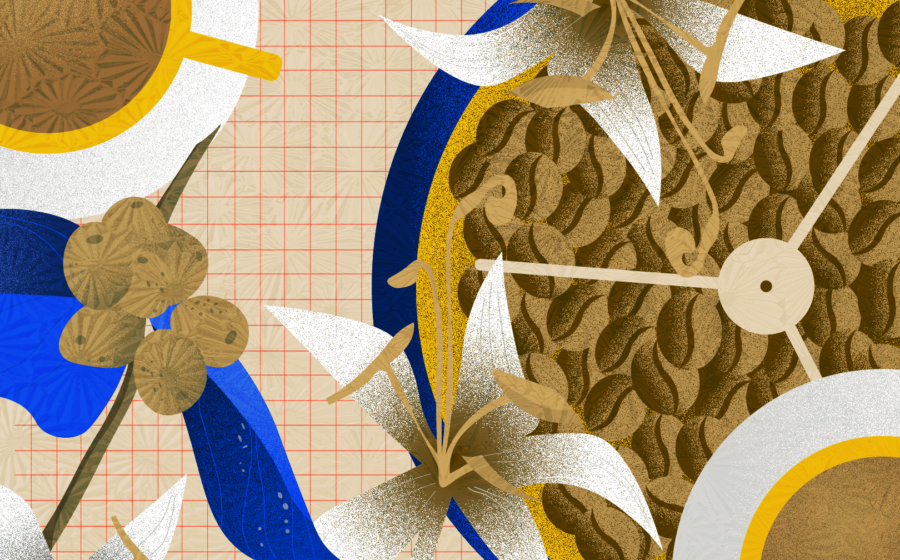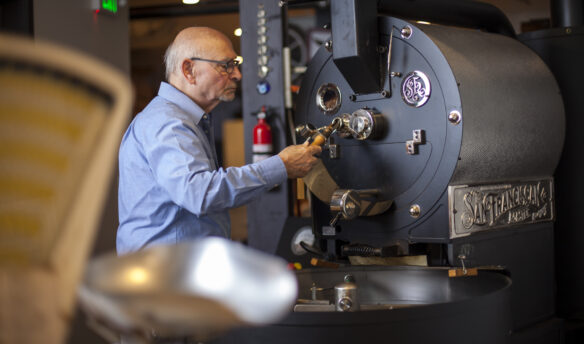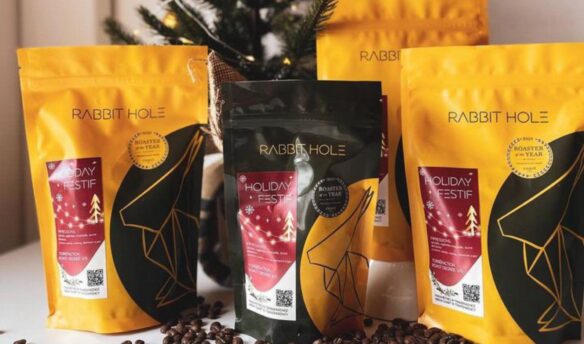Talk to any US third-wave roastery in cities, small or large, and you’ll likely meet a roaster who could wax eloquent on what the ideal roast curve for an Arabica Kenyan coffee should look like. Mention Robusta—from any country—and the conversation grinds to a halt. Most US-based specialty roasters solely sell Arabica beans. Add the fact that many Robustas end up as cheap, defect-ridden blend fillers, and there’s hardly any incentive to spend time on them.
Yet, on the heels of a Vietnam trip this past summer, Robusta was all I thought about. As the world’s largest Robusta producer, Vietnam hosts a specialty scene equally adept at roasting Arabicas and Robustas. Alongside the traditionally phin-brewed, condensed milk-mixed dark roasts exists a burgeoning scene of specialty coffee shops and roasters serving Robusta coffee. I tasted Robustas with notes of vanilla, coconut, and papaya, the coffees inhabiting a peculiar middle zone between classic Robustas’ heavy chocolate and nutty notes and some Arabicas’ fruity tartness.
As an Indonesian-born roaster focused on Asian coffees, I’d feel remiss to neglect a sizable part of coffee growing on the continent. While Vietnam is the world leader in Robusta production, countries like Indonesia, India, and Malaysia are also among the world’s biggest producers of this coffee. Not only is Asia a major source of Robusta, but many of the continent’s coffee-growing countries also consume a significant amount of Robusta coffee.
Fascinated by what I tasted in Vietnam, I sourced my first fine Robusta lot ever for my roastery through the importer Karmic Circle Coffee Trading—a Vietnamese anaerobic natural lot from the Central Highlands region of Bao Lac produced by Toi Nguyen. But I didn’t even know where to begin with profiling a Robusta roast. I decided to read and ask around. Luckily, there are already a few dedicated Robusta geeks in both Vietnam and the US.
“Time is an Ally”
So, how does one roast Robustas?
When it comes to Arabicas (Coffea arabica), many roasters would say that light roasts best express the coffee’s inherent flavors and sweetness. The emerging consensus for fine Robustas (Coffea canephora) lies more in the medium to medium-dark range. Coffee Quality Institute’s Fine Robusta Standards and Protocols cautions that for sample roasting, “Robusta whole bean roast color should be medium to medium-dark, not light to medium-light as is common for Arabica cupping roasts [Emphasis theirs].”
Roaster/producer Duc Le from Cafe Le J’ in Dalat, Vietnam, thinks that many roasters are still not used to handling fine Robustas. “If they do, they often tend to roast it darker than necessary,” he explains over email. “The ideal roast for fine Robusta lies somewhere between being too light, which results in an underdeveloped nutty taste, hollowness, acridness, and unpleasantness with medium-high acidity (for Robusta), and being too dark, which leads to oiliness, bitterness, lack of acidity, and destructive fruity or floral notes.”
Others, like Blue Bottle Coffee founder James Freeman, recommend a longer roast profile. “For robusta, time is an ally. Longer roasting cycles, which can bake the aromatics out of arabica, soften the harshness of robusta,” writes Freeman in a recent Saveur piece touting the potential of Robusta coffees.
The ideal roast for fine Robusta lies somewhere between being too light, which results in an underdeveloped nutty taste, hollowness, acridness, and unpleasantness with medium-high acidity (for Robusta), and being too dark, which leads to oiliness, bitterness, lack of acidity, and destructive fruity or floral notes. Duc Le, Cafe Le J’
It’s hard to nail down exact numbers for an ideal roast time for Robusta vis-a-vis Arabica. Different machines and profiles call for varying roast times. But, respective industry protocols for Arabica and Robusta sample roasting provide useful reference points. SCA recommends that Arabica sample roasting should finish between 8 and 12 minutes. Robusta, in contrast, ranges between 9 and 14 minutes.
The long approach to roasting robusta has a well-known precedent—Italians learned to embrace Robusta during Mussolini’s rule. “They discovered that robusta could be surprisingly delicious when roasted slowly in their rudimentary coal- and wood-powered machines, which steamed out any off flavors and gave robusta’s scant sugars time to develop.”
Freeman is not alone in thinking that long and slow is the way to go with Robustas, including the faulty ones. Hana Choi, owner of Saigon-based 96B Cafe and Roastery, tells me over a video call that “you can actually roast at low heat and eliminate a lot of hay, earthy or unpleasant aromas you don’t want in the beans.”
The approach helped Choi tame one Robusta lot in particular—an anaerobic natural lot that underwent an extremely long 16-day fermentation. “It’s very pungent, it has a very strong aroma…People in Vietnam say it tasted like fermented fish,” describes Choi with a laugh. She let the green coffee rest for another six months before trying a long roast. To her, the coffee “ends up being quite sweet. Some friends say [it tastes like] blueberries.” She admits that the roast may come off a little baked, or that the roast might have stalled a bit during the last few moments the coffee was in the roaster. “But when you de-gas [the coffee] and keep it for a few weeks, it’s very floral and very interesting.”
Nguyen Coffee Supply founder Sahra Nguyen, who’s done much to dispel misconceptions surrounding Robusta in the US, also believes in slowing things down. “In general, I take a low and slow approach to our robusta compared to our arabica,” writes Nguyen in an email. The strategy seems to have worked wonders for her Vietnamese anaerobic natural release from Dak Lak, a notably boozy and berry-forward Robusta. In his Saveur piece, Freeman mentions enjoying it as espresso using his vintage Faema Urania machine.
Nguyen went through six different test roasts before settling on a profile for her anaerobic lot. “Higher charge temp [the initial temperature of the drum in the roaster before you begin roasting] and more aggressive [rate of rise] from earlier batches brought out a lot more mulled spices in the anaerobic robusta, which was pretty pleasant, but I wanted to highlight the fruitiness with this particular robusta to really shift perceptions,” she writes.
The rate of rise measures the speed at which the temperature rises during a roast, and steering this variable—aggressive at one point, gentle at another—is key in creating a roast profile, as apparent in Nguyen’s account. “I started with a lower charge temp,” she continues, “and layered on the heat pretty consistently for the first two stages; since Robusta beans don’t crack as distinctly as Arabica, I relied more heavily on my sense of smell to determine when we were approaching the development stage and pulled heat back more aggressively upon entering the last stage.”
The anaerobic roast profile Nguyen developed is much gentler than the one she uses for her regular natural Robustas. The reason anaerobic coffees end up responding better to a lower and slower method, she believes, has to do with the long fermentation, which affects how the beans roast: “I found that our Robusta beans processed through an anaerobic natural method developed much quicker than our Robusta. This is probably due to the fermentation process breaking down the coffee bean through those eight days.”
The growing specialty Robusta category should dispel any notion that it is incapable of cleanness or sweetness. The quality is already here. Widening our view of coffee beyond a specialty Arabica monoculture to include Robusta requires a conscious act.
One key reason Robustas require a longer roast has to do with how differently their cellular structures absorb heat compared to Arabicas. As Josef Mott explains in a Perfect Daily Grind piece, Robusta’s bean structure has less density than Arabica but paradoxically mirrors the demeanor of a dense Arabica in the roasting drum: “Robusta beans are generally less dense than arabica, as they’re grown at lower altitudes and higher temperatures. However, their bean structure is far more complex, so confusingly, during the roast, robusta actually behaves like a very dense high-altitude arabica coffee.”
Brazilian Robusta farmer Lucas Venturim, as quoted in Mott’s piece, echoes the same sentiment. The grower explains that “the cellular structure of [Robusta] is more rigid, and this makes it behave similarly to denser grains, even though the apparent density is not so high[.]” Since Robusta’s inner bean transmits heat differently, Venturim suggests a higher starting/’charge‘ temperature for Robustas and a 5-7°C higher finishing temp, though without specifying to which processing method this would apply.
The Taste of Barley
My experience roasting Mr. Toi’s anaerobic robusta corroborated Venturim’s insight. I roasted the lot two ways: one, a gentler roast with a lower charge temp, the second with a higher charge and more aggressive heat throughout. Both ended at the same medium-roast temperature, with the aggressive roast ending about 20 seconds faster. These roasts roughly mirrored how I approach roasting softer Arabicas like natural Brazils and denser coffees like washed Colombias. The gentle profile gave a nice, soft chocolate impression with a palpable grain note (think toasted barley). Next to the gentler roast, the aggressive roast tasted fruitier, sweeter, and strikingly less grainy.
Graininess regularly shows up as a flavor descriptor for robusta coffees, but the difference between the aggressive and gentler roasts makes me suspect that a pronounced grain flavor signals inner underdevelopment. It tastes more like a roast defect, not an inherent flavor, analogous to the sharp sour, vegetal notes of under-roasted Arabicas.
The gentle profile gave a nice, soft chocolate impression with a palpable grain note (think toasted barley). Next to the gentler roast, the aggressive roast tasted fruitier, sweeter, and strikingly less grainy.
While developing a roast profile for Mr. Toi’s coffees, I frequently corresponded with Paradise Coffee Roasters owner and longtime Robusta advocate Miguel Meza. I asked him over email about my findings. He agrees that a sharp grain note would indicate under-roasting and flagged it as a risk in more lightly roasted Robustas. While elsewhere, he states that a longer, gentler profile for Robustas benefits their “sweetness and mouthfeel,” he cautions against too light of a touch. His reasoning is similar to Venturim’s. “I think from my experience with roasting robustas…is that they don’t seem to transfer heat to the inside of beans as easily as arabica,” warns Meza.
“So it is very easy to under roast them, to have a relatively high finish temperature, but the inside of the seed and the ground color is much lighter than you would expect from Arabica at that temperature. So, the graininess is from under development. Because most roasters try to roast very light as they do with Arabica, and with similar types of roast profiles, this goes a long way in shaping people’s negative perceptions of Robusta quality.”
What little I’ve learned about Robusta roasting, like pinpointing underdevelopment, exemplifies challenges that keep me from complacency as a roaster. While tasting an under-roasted bean was helpful, I feel nowhere close to figuring out this species. The few roasters I’ve been in touch with agree with the time-tested wisdom that Robusta overall responds well to low heat and longer roasts. Yet applying the heat too gently risks underdeveloping it, particularly when we strive for a lighter roast. What likely would explain this quirk, among other culprits, is Robusta’s odd anatomy: being less dense because of its lower growth elevation than Arabica, yet absorbing heat more like a dense coffee.
Countless roasters have endlessly parsed the finer stylistics of an Arabica roast. When it comes to Robusta, we’re still grasping the basic grammar, far from fully decoding its idioms and idiosyncrasies. As Meza puts it, “In terms of intentionally producing quality, Robusta is 30 years behind arabica, and the best today is probably nowhere near the potential of the species.”
Meza and the others interviewed for this piece actively prove that fine Robusta roasting demands just as much care and curiosity as Arabica. The growing specialty Robusta category should dispel any notion that it is incapable of cleanness or sweetness. The quality is already here. Widening our view of coffee beyond a specialty Arabica monoculture to include Robusta requires a conscious act. It’s not inevitable. To borrow from the poet Charles Wright, “If it’s hidden, it’s we who hide.”















